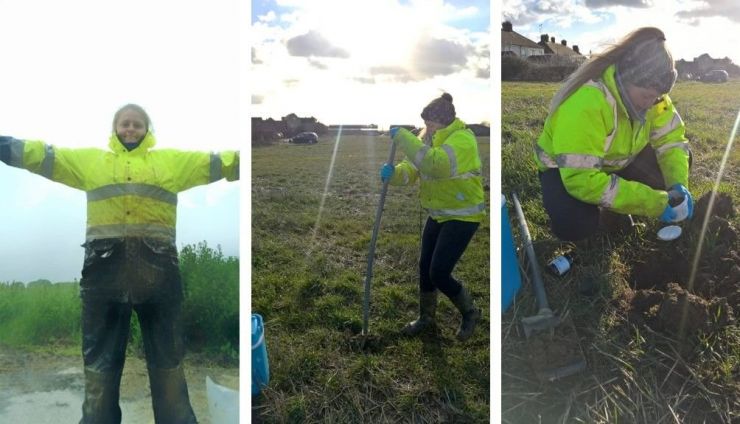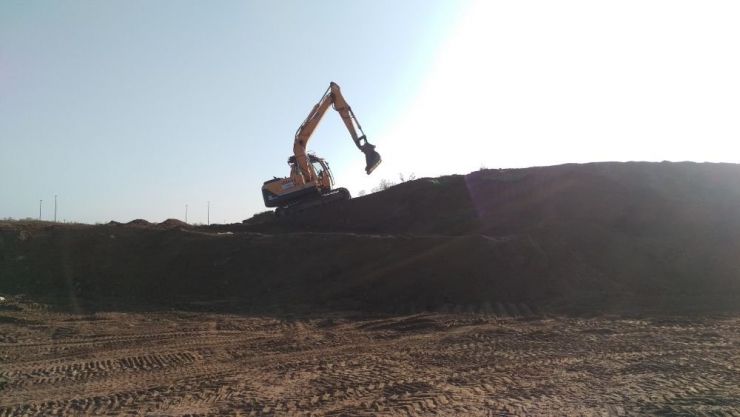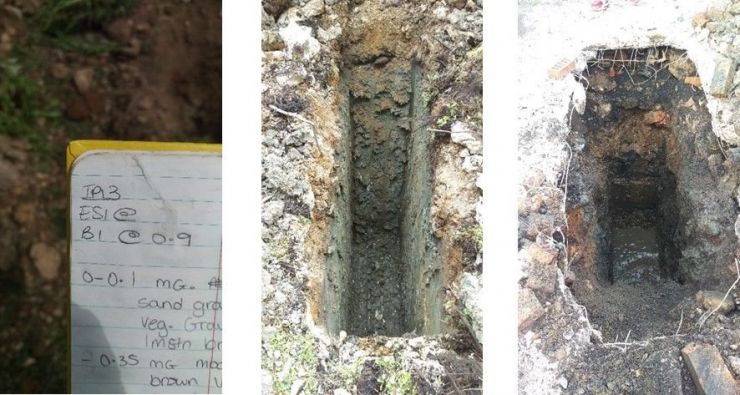Careers
Chloe - Geotechnical Project Engineer
This is Chloe, one of our Geotechnical Project Engineers. She first joined Rolton Group in June 2017 as a Graduate Engineer and was promoted to a Project Engineer at the beginning of 2019. We caught up with Chloe to see what it is like to be a Geotechnical Engineer.
What do you enjoy most about your role?
In my role, I have the opportunity to work on a variety of projects – some sites can be very similar but never 100% the same. As part of completing a desk study for a site, I look through historic maps and learn about the previous uses of the land, which could be as simple as being agricultural farmland or something a bit different like an old RAF base used during WWII or a government testing facility. When designing the ground investigations, certain areas will be targeted based on the historical use, so you might dig up buried building foundations or the footprint of a historic runway, which is really interesting.
I enjoy seeing the transformation of sites and the result of all the hard work that goes into creating new buildings/developments. Recently, the new Mercedes-Benz Centre of Excellence for Used Cars opened in Erdington and I helped with the site investigations and phase 2 geo reporting for this project. The site investigations for this development were completed in two stages.
Stage 1 consisted of investigating the ground conditions and identifying any obstructions in the immediate vicinity of the original showroom by means of trial pits and boreholes, with the addition of hand dug pits to identify the details of the existing foundations. Findings from this allowed our civil and structural teams to make informed decisions about the next steps of design. Stage 2 involved undertaking trial pits on an adjacent plot of land, occupied by a derelict school building, to provide data for the demolition of the school and the construction of a temporary showroom in order for sales to continue during the development. The completed dealership facility looks amazing and it was a great project to be a part of.

I also love being able to work outdoors. As much as the early mornings can sometimes be tough, arriving on site as the sun rises is very rewarding; I’ve seen some stunning sunrises since I started here. Being out in the fresh air is great for a person’s general well-being too. I find the trickier and more complex projects are also some of the most interesting and rewarding; they provide great opportunities to learn and are usually more memorable.
We see quite a bit of wildlife and meet a few animals whilst on site. I’ve seen foxes bouncing around in woodland, pheasants darting through long grass and kites circling overhead. Much larger animals have also been seen on site including deer, sheep, cows and horses; the sheep and deer are usually very quick to make themselves scarce whereas the cows and horses have shown a lot of curiosity towards what is happening.

I remember a site in Northampton during summer 2017 where we had to complete soakaway testing in a field that contained horses. They showed a lot of interest to the mound of soil at the side of the soakaway but even more interest to the car I’d travelled in that day. There were a group of them surrounding the car and some of them even licking the bonnet; when I got into the car to drive away they were very reluctant to move. I waited about 15 minutes with no luck so had to slowly reverse out of their way since they showed little sign of backing away themselves.

What is the most challenging aspect of your role?
As well as being rewarding, site work does come with some challenges. During winter the weather can be very wet and very cold, so it’s always important to wear plenty of layers to keep warm and invest in a good set of waterproofs; some sites are just open fields with no facilities and nowhere to dry out or warm up.
However, this can be managed quite easily. I’d recommend spending some time outside, going for long walks so you get used to being on your feet all day and finding good warm layers that work for you. I get cold quite easily so I’m usually the most wrapped up person on site.
What advice would you give anyone looking to become an engineer/get into the construction industry?
This career definitely keeps you busy all day every day and provides a great variety of projects and opportunities. If you are considering becoming a geotechnical or geo-environmental engineer, I’d recommend doing lots of research, having a science background, spend time outdoors and seek out as many opportunities as possible.
What does your typical day consist of?
It’s quite tricky to describe a typical day because the geo team undertake a huge range of geotechnical and geo-environmental work which all have a range of tasks to complete. Typically, our clients require us to produce Phase 1 and Phase 2 reports, with a few extra tasks included in-between.

A Phase 1 report generally consists of an assessment of the data you can acquire without completing any intrusive ground investigations. This involves looking through historic maps, aerial photographs and Google Earth to piece together the history of the site. Geological and hydrological maps will be studied to give a general indication of what the ground conditions are likely to be. A site walkover is completed in order to assess the current appearance and layout of the site. All of the information is reviewed along with any design and development plans provided by the client, and then compiled into a report with recommendations for future investigations.

A Phase 2 report includes all of the above as well as the results of intrusive ground investigations. Designing the investigations requires a review of the desk study (or of the data used in a desk study if not already completed) and liaising with the client to identify any limiting factors for the work. A proposed exploratory hole layout will be designed on an existing topographical survey using AutoCAD. Based on the type of investigations to be completed, dates are scheduled and sub-contractors are booked for the work. A set of Risk Assessments and Methods Statements (RAMS) will be written up, including information on services known to be on the site, and if private services are thought to exist a specialist service avoidance contractor will also be booked to scan all exploratory hole locations prior to excavation or drilling.
When on the site, a morning briefing is held at 8am and then works can begin. If completing trial pits, the machine operator will excavate the locations you’ve mapped out whilst you sample the soils and log the hole to the desired depth (this is usually around 3m depth). Photos are taken and the hole is backfilled. If boreholes are being completed, an engineer from the geo team will meet the drillers on site, locate and scan the positions for services and then leave the drillers to complete the work.

Different types of samples are collected to be tested and produce data for writing the report, and the engineer who supervised the on-site work is usually the designated person who schedules the testing on particular samples.
Bulk samples are large soil samples of around 5-7kg, placed in bags, sealed and sent to a geotechnical testing laboratory. Usually these samples are tested for their pH and Sulphate content (this determines the type of concrete that can be used on the development) and Plasticity and Moisture content (these tests indicate the minimum depth for foundations on site).

Smaller environmental samples are usually taken of the near surface soils, most often topsoil or made ground, sealed in white tubs and amber jars and sent to a chemical testing laboratory where chemical analyses for a broad range of determinants are undertaken.
The logs are written up, a completed exploratory hole layout is produced and the testing results received. All of this data is compiled and assessed, including everything previously mentioned for the Phase 1, and the Phase 2 report produced.
Additional tasks for either existing projects as a continuation of the Phase 2 or for new projects may include monitoring ground gas and groundwater in wells installed on site, ground investigations to inform pile design, inspection of gas membranes and validating house plots (topsoil, capping layers, and foundations).
On-Site example
A site that I’ve been working on recently in Northamptonshire required testing of stockpiles of soils excavated by archaeologists, to help determine whether the soil could be used on-site as fill material or whether it would need to be taken away. By reporting on the soil composition (using Particle Size Distribution (PSD) plots and determining the organic content) we helped the client decide how best to handle the existing material on-site, informing the next steps of the project and indicating the potential benefits and cost implications of the most appropriate option.
Final thoughts
Overall, there is huge variety in the tasks involved within the role of Geotechnical Project Engineer, which keeps everyday interesting and ensures you develop a huge amount of knowledge across lots of areas. If you are someone who enjoys the outdoors and you have a keen eye for detail, you will likely find this role very rewarding. You receive lots of support and training both on-site and in the office to help develop a large and well-rounded understanding of both the geo-environmental and geotechnical aspects of the role, and it is a great pathway to follow which can lead to gaining chartership status and other additional qualifications in the wider world of geoscience and engineering.
